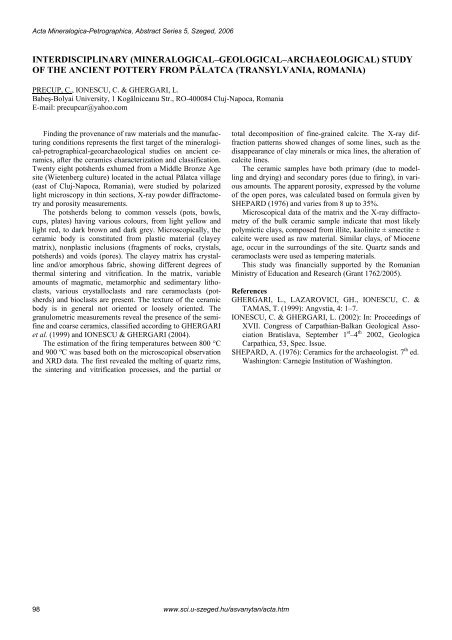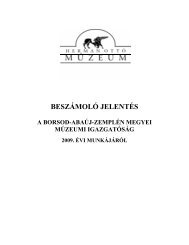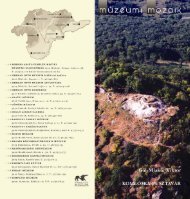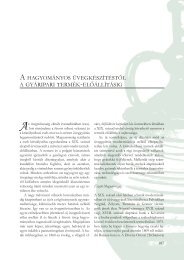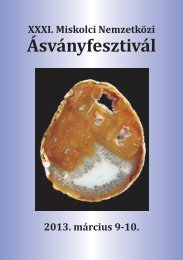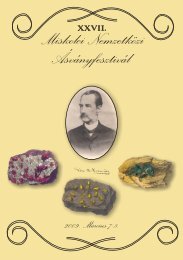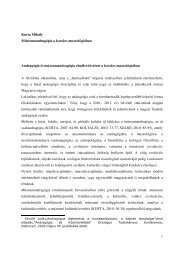Acta Mineralogica-Petrographica, Abstract Series 5, Szeged, 2006<strong>IN</strong>TERDISCIPL<strong>IN</strong>ARY (<strong>M<strong>IN</strong>ERAL</strong>OGICAL–GEOLOGICAL–ARCHAEOLOGICAL) STUDYOF <strong>THE</strong> ANCIENT POTTERY FROM PĂLATCA (TRANSYLVANIA, ROMANIA)PRECUP, C., IONESCU, C. & GHERGARI, L.Babeş-Bolyai University, 1 Kogălniceanu Str., RO-400084 Cluj-Napoca, RomaniaE-mail: precupcar@yahoo.comFinding the provenance of raw materials and the manufacturingconditions represents the first target of the mineralogical-petrographical-geoarchaeologicalstudies on ancient ceramics,after the ceramics characterization and classification.Twenty eight potsherds exhumed from a Middle Bronze Agesite (Wietenberg culture) located in the actual Pălatca village(east of Cluj-Napoca, Romania), were studied by polarizedlight microscopy in thin sections, X-ray powder diffractometryand porosity measurements.The potsherds belong to common vessels (pots, bowls,cups, plates) having various colours, from light yellow andlight red, to dark brown and dark grey. Microscopically, theceramic body is constituted from plastic material (clayeymatrix), nonplastic inclusions (fragments of rocks, crystals,potsherds) and voids (pores). The clayey matrix has crystallineand/or amorphous fabric, showing different degrees ofthermal sintering and vitrification. In the matrix, variableamounts of magmatic, metamorphic and sedimentary lithoclasts,various crystalloclasts and rare ceramoclasts (potsherds)and bioclasts are present. The texture of the ceramicbody is in general not oriented or loosely oriented. Thegranulometric measurements reveal the presence of the semifineand coarse ceramics, classified according to GHERGARIet al. (1999) and IONESCU & GHERGARI (2004).The estimation of the firing temperatures between 800 °Cand 900 ºC was based both on the microscopical observationand XRD data. The first revealed the melting of quartz rims,the sintering and vitrification processes, and the partial ortotal decomposition of fine-grained calcite. The X-ray diffractionpatterns showed changes of some lines, such as thedisappearance of clay minerals or mica lines, the alteration ofcalcite lines.The ceramic samples have both primary (due to modellingand drying) and secondary pores (due to firing), in variousamounts. The apparent porosity, expressed by the volumeof the open pores, was calculated based on formula given bySHEPARD (1976) and varies from 8 up to 35%.Microscopical data of the matrix and the X-ray diffractometryof the bulk ceramic sample indicate that most likelypolymictic clays, composed from illite, kaolinite ± smectite ±calcite were used as raw material. Similar clays, of Mioceneage, occur in the surroundings of the site. Quartz sands andceramoclasts were used as tempering materials.This study was financially supported by the RomanianMinistry of Education and Research (Grant 1762/2005).ReferencesGHERGARI, L., LAZAROVICI, GH., IONESCU, C. &TAMAS, T. (1999): Angvstia, 4: 1–7.IONESCU, C. & GHERGARI, L. (2002): In: Proceedings ofXVII. Congress of Carpathian-Balkan Geological AssociationBratislava, September 1 st –4 th 2002, GeologicaCarpathica, 53, Spec. Issue.SHEPARD, A. (1976): Ceramics for the archaeologist. 7 th ed.Washington: Carnegie Institution of Washington.98www.sci.u-szeged.hu/asvanytan/acta.htm
Acta Mineralogica-Petrographica, Abstract Series 5, Szeged, 2006<strong>M<strong>IN</strong>ERAL</strong>OGICAL AND PETROGRAPHICAL STUDY OF MIDDLE BRONZE AGECERAMICS FROM DERŞIDA (NW TRANSYLVANIA, ROMANIA)PRECUP, C., IONESCU, C., GHERGARI, L. & SIMON, V.Babeş-Bolyai University, 1 Kogălniceanu Str., RO-400084 Cluj-Napoca, RomaniaE-mail: precupcar@yahoo.comTwenty two fragments selected from hundreds of potteryremnants excavated in 60s at Derşida site in the northwesternpart of Transylvania (Romania), were studied bypolarized light microscopy, X-ray powder diffractometry,scanning electron microscopy (SEM) and thermal analyses.Archaeologically, the pottery remnants belong to the Wietenbergculture (around 1800-1300 BC), i.e. Middle BronzeAge. The potsherds have a brownish-grayish colour, sometimeseven blackish, with a smoothed surface, frequentlydecorated by incision or imprinting.Microscopically, the ceramic body is composed from aclayey matrix, in which various nonplastic inclusions (clasts)and voids occur. Granulometrically, most of the samples(77%) have coarse characteristics, while 23% belong to thesemifine category. The clayey matrix is thermally sinterizedand has an amorphous-crystalline fabric. The porosity, expressedby primary and secondary pores, is relatively high.The inclusions are represented by crystalloclasts (quartz,plagioclase feldspar, biotite, muscovite, calcite and rarelygarnets, epidote, zircon, titanite, tourmaline, apatite), lithoclasts(various metamorphic, magmatic and sedimentaryrocks), ceramoclasts (potsherds) and rare bioclasts (fossilremnants). In cross section a general chaotic orientation ofthe lamellar particles, rarely a slight parallel arrangement tothe wall of the ceramics can be noticed.X-ray diffraction patterns show the presence of mineralcomponents as muscovite, biotite, chlorite, feldspar as well asthe thermally-modified lines of kaolinite, illite, montmorilloniteand illite/montmorillonite. The thermal analyses point toendothermic effects at 50-200 °C, due to the adsorbed-waterloss, at 400 °C, due to the loss of OH - from the clay mineralsstructure and the last, at 650-800 °C, due to the structuralcollapse of some of the clay minerals. SEM images revealdifferent degrees of sinterization-melting processes whichhad affected mainly the clayey matrix and less the clasts.The mineralogical composition of the matrix points outthe use of a reddish clay (Late Pleistocene age) occurringwest of the site, as raw material. The clasts composition reflectsthat the ancient potters used sands from the alluvialsediments of the Crasna river, as tempering material for ceramics.Based on the microscopical observations, the modificationof the X-ray diffraction lines of clay minerals, thethermal analyses and SEM, compared with reference data(e.g. MAGGETTI, 1982; CULTRONE et al., 2001, etc.) wemay consider that the firing temperature of the MiddleBronze Age ceramics from Derşida exceeded 600 °C (kaolinitebasal line is missing) but not more than 900 °C (as calciteis still thermally unchanged).This study was financially supported by the RomanianMinistry of Education and Research (Grant 1762/2005).ReferencesCULTRONE, G., RODRIGUEZ-NAVARRO, C.,SEBASTIAN, E., CAZALLA, O. & DE LA TORRE,M.J. (2001): European Journal of Mineralogy, 13: 621–634.MAGGETTI, M. (1982) in OL<strong>IN</strong>, J.S. & FRANKL<strong>IN</strong>, A.D.(eds.): Archaeological ceramics, Washington, DC: SmithsonianInstitution, 121–133.www.sci.u-szeged.hu/asvanytan/acta.htm 99
- Page 1:
MSCC33 rd MINERAL SCIENCES IN THE C
- Page 5 and 6:
Acta Mineralogica-Petrographica, Ab
- Page 7 and 8:
Acta Mineralogica-Petrographica, Ab
- Page 9 and 10:
Acta Mineralogica-Petrographica, Ab
- Page 11 and 12:
Acta Mineralogica-Petrographica, Ab
- Page 13 and 14:
Acta Mineralogica-Petrographica, Ab
- Page 15 and 16:
Acta Mineralogica-Petrographica, Ab
- Page 17 and 18:
Acta Mineralogica-Petrographica, Ab
- Page 19 and 20:
Acta Mineralogica-Petrographica, Ab
- Page 21 and 22:
Acta Mineralogica-Petrographica, Ab
- Page 23 and 24:
Acta Mineralogica-Petrographica, Ab
- Page 25 and 26:
Acta Mineralogica-Petrographica, Ab
- Page 27 and 28:
Acta Mineralogica-Petrographica, Ab
- Page 29 and 30:
Acta Mineralogica-Petrographica, Ab
- Page 31 and 32:
Acta Mineralogica-Petrographica, Ab
- Page 33 and 34:
Acta Mineralogica-Petrographica, Ab
- Page 35 and 36:
Acta Mineralogica-Petrographica, Ab
- Page 37 and 38:
Acta Mineralogica-Petrographica, Ab
- Page 39 and 40:
Acta Mineralogica-Petrographica, Ab
- Page 41 and 42:
Acta Mineralogica-Petrographica, Ab
- Page 43 and 44:
Acta Mineralogica-Petrographica, Ab
- Page 45 and 46:
Acta Mineralogica-Petrographica, Ab
- Page 47 and 48: Acta Mineralogica-Petrographica, Ab
- Page 49 and 50: Acta Mineralogica-Petrographica, Ab
- Page 51 and 52: Acta Mineralogica-Petrographica, Ab
- Page 53 and 54: Acta Mineralogica-Petrographica, Ab
- Page 55 and 56: Acta Mineralogica-Petrographica, Ab
- Page 57 and 58: Acta Mineralogica-Petrographica, Ab
- Page 59 and 60: Acta Mineralogica-Petrographica, Ab
- Page 61 and 62: Acta Mineralogica-Petrographica, Ab
- Page 63 and 64: Acta Mineralogica-Petrographica, Ab
- Page 65 and 66: Acta Mineralogica-Petrographica, Ab
- Page 67 and 68: Acta Mineralogica-Petrographica, Ab
- Page 69 and 70: Acta Mineralogica-Petrographica, Ab
- Page 71 and 72: Acta Mineralogica-Petrographica, Ab
- Page 73 and 74: Acta Mineralogica-Petrographica, Ab
- Page 75 and 76: Acta Mineralogica-Petrographica, Ab
- Page 77 and 78: Acta Mineralogica-Petrographica, Ab
- Page 79 and 80: Acta Mineralogica-Petrographica, Ab
- Page 81 and 82: Acta Mineralogica-Petrographica, Ab
- Page 83 and 84: Acta Mineralogica-Petrographica, Ab
- Page 85 and 86: Acta Mineralogica-Petrographica, Ab
- Page 87 and 88: Acta Mineralogica-Petrographica, Ab
- Page 89 and 90: Acta Mineralogica-Petrographica, Ab
- Page 91 and 92: Acta Mineralogica-Petrographica, Ab
- Page 93 and 94: Acta Mineralogica-Petrographica, Ab
- Page 95 and 96: Acta Mineralogica-Petrographica, Ab
- Page 97: Acta Mineralogica-Petrographica, Ab
- Page 101 and 102: Acta Mineralogica-Petrographica, Ab
- Page 103 and 104: Acta Mineralogica-Petrographica, Ab
- Page 105 and 106: Acta Mineralogica-Petrographica, Ab
- Page 107 and 108: Acta Mineralogica-Petrographica, Ab
- Page 109 and 110: Acta Mineralogica-Petrographica, Ab
- Page 111 and 112: Acta Mineralogica-Petrographica, Ab
- Page 113 and 114: Acta Mineralogica-Petrographica, Ab
- Page 115 and 116: Acta Mineralogica-Petrographica, Ab
- Page 117 and 118: Acta Mineralogica-Petrographica, Ab
- Page 119 and 120: Acta Mineralogica-Petrographica, Ab
- Page 121 and 122: Acta Mineralogica-Petrographica, Ab
- Page 123 and 124: Acta Mineralogica-Petrographica, Ab
- Page 125 and 126: Acta Mineralogica-Petrographica, Ab
- Page 127 and 128: Acta Mineralogica-Petrographica, Ab
- Page 129 and 130: Acta Mineralogica-Petrographica, Ab
- Page 131 and 132: Acta Mineralogica-Petrographica, Ab
- Page 133 and 134: Acta Mineralogica-Petrographica, Ab


